- MOE
- National Parks of Japan
- Nikko National Park
- Characteristics
main body

Characteristics
Colorful natural beauty and sublime cultural heritages interweaved by mountains, lakes, reservoirs, falls and wetlands.
Date of Designation: December 4,1934
Area: 114,908 ha
Related Prefecture: Fukushima, Tochigi, Gunma
Area: 114,908 ha
Related Prefecture: Fukushima, Tochigi, Gunma
Nikko National Park is the one of first national parks that opened in 1934. The park area straddles Fukushima, Tochigi, and Gunma Prefectures and the total area is 114,908 ha. Most of the area is a mountainous region of the Nasu Volcanic Belt with such mountains as Mt. Shirane (2,578 m above sea level), the highest peak in the northern Kanto region; Mt. Nantai (2,486 m above sea level), which has been renowned as an object of worship from ancient times; and Mt. Nasudake (1,917 m above sea level), which is still an active volcano. These mountains have wideplateaus at their bases, and the additional beauty of lakes, reservoirs, magnificent falls, and valleys with splendid autumn leaves, all of which were created by volcanic activity.
In addition, there is the beautiful fusion of a number of historic world-heritage temples and shrines and the natural scenery surrounding them.
Nikko National Park boasts easy access by train or car from areas around Tokyo and is, therefore, popular as a spot where visitors can experience nature, history, and culture.
In addition, there is the beautiful fusion of a number of historic world-heritage temples and shrines and the natural scenery surrounding them.
Nikko National Park boasts easy access by train or car from areas around Tokyo and is, therefore, popular as a spot where visitors can experience nature, history, and culture.
Terrain/ Scenery

Mt. Chausudake Emitting Volcanic Fumes
Nasukashi / Shiobara Area
The Nasukashi and Shiobara area has volcanic mountains and large plateaus, with representing Mt. Chausu that is still fuming. There also are many strands of valleys formed after mountains and plateaus were eroded by a number of rivers, such as the Abukuma River.
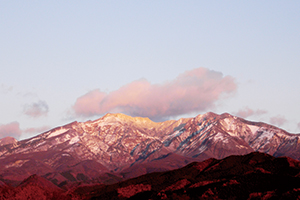
Mt. Nyoho (stratovolcano)
Nikko / Kinugawa / Kuriyama Areas
The Nikko/Kinugawa/Kuriyama areas have stratovolcanos of Mt. Nantai, Mt. Nyoho and Mt. Akanagi, as well as many lava domes and small volcanoes, which are collectively called the Nikko volcanic group.
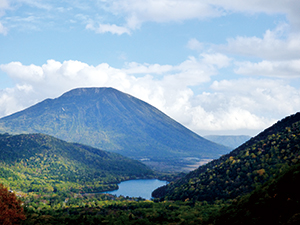
Mt. Nantai and Lake Yunoko (stratovolcano and dammed lake formed by lava flows)
At the bases and hillsides of the Nikko volcanic group are lakes, reservoirs, wetlands, and falls created by the effect of volcanic activities and offer the visitor a rich variety of topography and geological features.
Plants
Nasukashi / Shiobara Area
From the mountain bases to the hillsides, this area is covered by rich forests, and as the elevation increases, the landscape changes from broadleaf deciduous forests of Japanese beech and oak trees at the bases to coniferous forests mainly of fir and Thuja trees. On the ridgelines along the peaks of Mt. Nasudake, although the elevation is less than 2,000 m, visitors can observe alpine vegetation, such as creeping pine trees, because of the cold climate and volcanic soil among other factors.Plants are very wide in variety, and species belonging both to the Pacific side and the Sea-of-Japan side are seen. Characteristic plants include alpine plants on Mt. Nasudake and marsh plants in Numappara Moor.
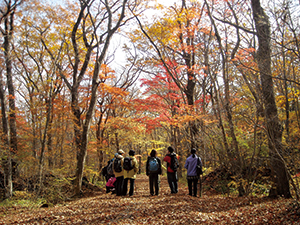
Broadleaf Forest of Nasu Heisei-no-mori Forest
Nikko / Kinugawa / Kuriyama Areas
At the foot of the mountains are a deciduous broadleaf forest zone of mainly Japanese beech and oak with some maple, showing stunning colored-leaf scenes in autumn. Coniferous forests are prominent in areas above an altitude of about 1,600 m, and Erman's birch trees are in even higher places. The ridgelines and summits, above the altitude of about 2,400 m, are characterized by shrubby, herbaceous alpine-belt vegetation, providing unobstructed open views. On the flat areas on hillsides and at the bases, there are such wetlands as Kinu-numa Swamp and Senjogahara.
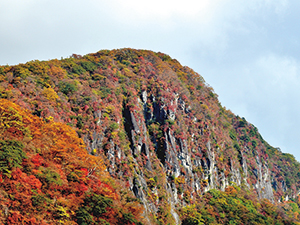
Colored Leaves on Byobuiwa Cliff (broadleaf forest at the foot of the mountain)
This area is inhabited by a very wide variety of flora due to the varied geography and vegetation.
For plants, the flora native to wetlands and alpine belt are typical, some of which even have the word "Nikko" in their names.
For plants, the flora native to wetlands and alpine belt are typical, some of which even have the word "Nikko" in their names.
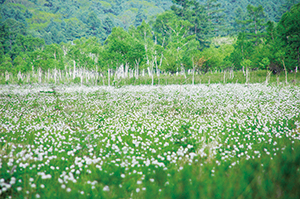
Cottongrass at Senjogahara (marsh plant)
Wildlife
Nasukashi / Shiobara Area
This area is inhabited by animals often seen on Japan's main island, including large mammals like the Japanese serows , Japanese sika deer , and Asian black bear, as well as valley fish and amphibian species.
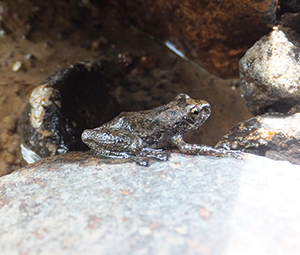
Buerger's Frog Living by the Stream
Nikko / Kinugawa / Kuriyama Areas
This area is inhabited by a very wide variety of flora and fauna due to the varied geography and vegetation. As for animals, large and small mammals live supported by the forest. Among them, the habitat density of Japanese sika deer and Japanese macaque is higher.
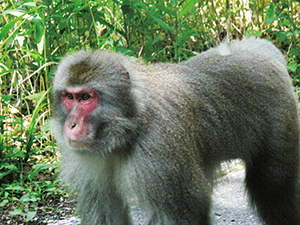
Japanese Macaque
Culture
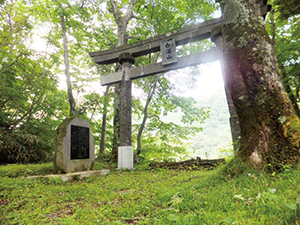
Hakutosan Oh-torii Gate
Nasukashi / Shiobara Area
On the peaks of the Mt. Nasudake, Shugen-do (Buddhist austerities) mountain worship called "Hakutosan Worship" used to be active. There are related historical sites in Sando-goya Onsen and other places.

Shrines and Temples of Nikko (Futarasan-jinja Shrine)
Nikko / Kinugawa / Kuriyama Areas
Especially in and around the Nikko city area, there are many historical buildings and sites, such as Tosho-gu Shrine, Futarasan-jinja Shrine, and Rinno-ji Temple, which are assets forming the Shrines and Temples of Nikko, a World Heritage Site. Rich forests surround these, creating unique scenes where the natural environment and history/culture are integrated.
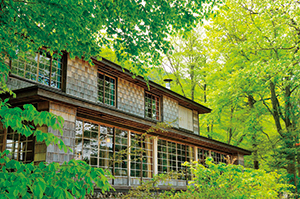
Italian Embassy Villa Memorial Park
The areas around Lake Chuzenji used to be popular in and after the Meiji era as a summer resort for diplomats posted in Japan and foreign-government officers, and there is a park on the site of an embassy and some active embassy villas.
